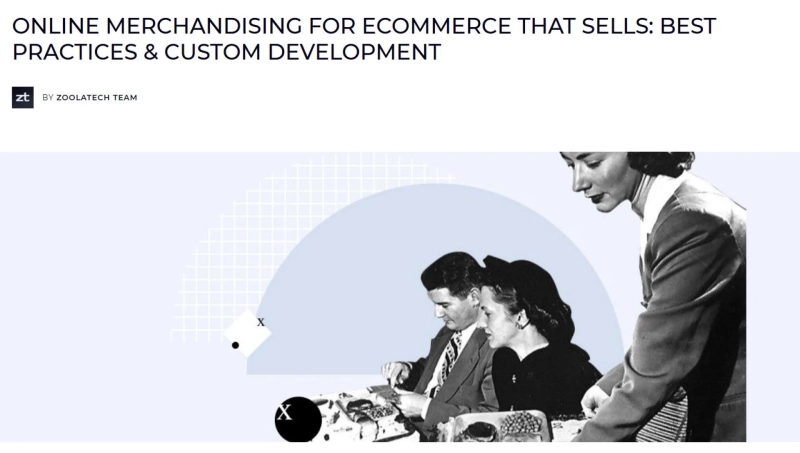Introduction: From Static Displays to Personalized Experiences
The retail landscape has transformed dramatically over the past decade. What was once a simple online catalog has evolved into a dynamic, data-driven ecosystem that anticipates what shoppers want before they even know it themselves. This transformation is powered by dynamic merchandising — a strategy that leverages real-time data, machine learning, and customer insights to deliver personalized product recommendations and curated experiences for every shopper.
Unlike static merchandising, where every visitor sees the same set of products or promotions, dynamic merchandising tailors content, product placement, and messaging to individual behavior and context. Whether it’s highlighting trending items, showing complementary products, or adjusting prices dynamically, this approach ensures that each interaction is as relevant as possible.
Companies like Zoolatech are helping retailers embrace this evolution through intelligent automation, robust data analytics, and cutting-edge ecommerce merchandising solution that bring personalization to the forefront of digital commerce.
What Is Dynamic Merchandising?
Dynamic merchandising is the practice of adapting online store layouts, product displays, and recommendations in real time based on user data and contextual signals. It’s about curating a shopping experience that responds instantly to customer intent.
Instead of manually setting which products appear on a page, retailers use algorithms that evaluate multiple factors, such as:
- User behavior: Browsing history, time spent on pages, and items added to cart.
- Demographics: Age, location, and language preferences.
- Context: Device type, referral source, or even local weather conditions.
- Trends and inventory: Bestsellers, new arrivals, or overstocked items.
When done correctly, dynamic merchandising becomes a self-learning system that continuously optimizes how products are presented to maximize engagement, conversion, and average order value (AOV).
Why Real-Time Product Curation Matters
1. Shoppers Expect Personalization
Today’s consumers are accustomed to platforms like Amazon, Netflix, and Spotify that use sophisticated recommendation engines. They expect the same level of personalization from every brand they interact with. A one-size-fits-all approach feels outdated and impersonal.
Dynamic merchandising bridges this expectation gap by presenting relevant, timely, and individualized product selections. The shopper feels understood, and the brand gains loyalty and trust.
2. It Drives Conversions and Revenue
According to recent retail analytics studies, personalized product recommendations can increase conversion rates by up to 30% and boost average order values by 50% or more. When shoppers are shown products that align with their interests and real-time needs, they’re far more likely to make a purchase.
3. It Keeps Inventory Moving Efficiently
Retailers often face challenges with overstock or understock situations. Dynamic merchandising uses inventory-aware algorithms that automatically promote products based on availability and demand. This not only prevents missed sales but also reduces the costs associated with markdowns or excess stock.
4. It Enhances the Customer Journey
Dynamic merchandising doesn’t stop at the product page. It influences the entire journey, from the homepage and category listings to cart recommendations and post-purchase emails. By ensuring relevance at every step, brands can deliver a seamless and engaging shopping experience.
How Dynamic Merchandising Works
Dynamic merchandising operates at the intersection of data, algorithms, and automation. Let’s break down the core components that make this technology work.
1. Data Collection and Integration
The process starts with collecting and integrating diverse data sources:
- Website and app behavior tracking
- CRM and loyalty program data
- Purchase history and wish lists
- Demographic and geographic information
- External data (weather, holidays, social trends)
Platforms like Zoolatech’s ecommerce merchandising solution are designed to unify this data, transforming fragmented insights into a single, actionable customer view.
2. Machine Learning and Predictive Modeling
At the heart of dynamic merchandising are machine learning algorithms that analyze behavioral patterns to predict future actions. For example:
- If a shopper frequently buys eco-friendly products, the system will prioritize sustainable options.
- If they abandon carts during discount periods, they might be shown limited-time offers.
- If the system detects a high demand for a product in a certain region, it can auto-promote related items to local shoppers.
The more data the system processes, the smarter and more precise it becomes.
3. Automated Product Curation
Dynamic merchandising engines automatically adjust which products appear, in what order, and under what conditions. This automation ensures that product visibility is not static but evolves continuously based on user context and business goals.
Examples include:
- Displaying “Recently Viewed” or “Similar Products” modules.
- Highlighting best-selling items within a specific category.
- Promoting seasonal or time-sensitive offers dynamically.
- Suggesting bundles to increase AOV.
4. Continuous Testing and Optimization
The system doesn’t just set and forget — it learns. Through A/B testing, real-time analytics, and conversion tracking, it identifies which layouts, product assortments, and calls-to-action perform best. Over time, this creates a virtuous cycle of continuous improvement.
Use Cases Across Retail Sectors
Dynamic merchandising can be adapted to virtually any retail vertical. Here’s how it manifests across different industries:
Fashion and Apparel
- Personalizing product displays based on size availability and previous style preferences.
- Highlighting trending looks based on seasonality or influencer campaigns.
- Suggesting matching accessories at checkout.
Electronics
- Recommending complementary products like chargers, cases, or warranties.
- Displaying comparisons between similar models.
- Dynamically adjusting prices during promotions or flash sales.
Beauty and Health
- Tailoring suggestions based on skin type, age, or past purchases.
- Offering subscription options for recurring products like supplements or skincare.
- Highlighting user-generated content and reviews to build trust.
Home and Lifestyle
- Showing products based on room type, color palette, or style preferences.
- Promoting limited-edition items when stock levels are low.
- Curating bundles for home makeovers or gifting occasions.
Benefits of Dynamic Merchandising for Retailers
1. Increased Sales and Engagement
By aligning product visibility with shopper intent, retailers can see significant lifts in conversion rates and repeat purchases.
2. Improved Inventory Turnover
Automated product prioritization ensures that both fast-moving and slow-moving items receive appropriate exposure, optimizing stock levels and cash flow.
3. Enhanced Customer Loyalty
When customers feel that a brand “gets them,” they’re more likely to return. Dynamic merchandising builds emotional connection through relevance and consistency.
4. Higher Marketing ROI
By integrating personalization into the shopping experience, marketers can reduce wasted ad spend and achieve better ROI across campaigns.
5. Scalability
Dynamic merchandising eliminates manual work. Whether a retailer has 500 SKUs or 50,000, the system can scale effortlessly to handle complex catalogs and diverse audiences.
The Role of AI and Data Science in Dynamic Merchandising
Artificial Intelligence (AI) has become the backbone of modern merchandising strategies. Through predictive analytics and natural language processing (NLP), AI systems can interpret user signals far beyond simple clicks.
Key AI Capabilities Include:
- Behavioral clustering: Grouping customers with similar interests or purchase patterns.
- Real-time segmentation: Creating micro-segments that adapt as behavior changes.
- Contextual relevance: Understanding intent based on time, location, or even device.
- Image and sentiment analysis: Matching visual preferences and reading customer mood through reviews or interactions.
Zoolatech, known for its advanced AI-driven commerce solutions, integrates these capabilities into its ecommerce merchandising solution, helping retailers bridge the gap between data insights and actionable personalization.
Integrating Dynamic Merchandising with Other Systems
For dynamic merchandising to deliver full value, it must connect seamlessly with other elements of the digital commerce ecosystem, including:
- Content Management Systems (CMS): To control how dynamic elements appear within editorial content.
- Customer Data Platforms (CDPs): To unify customer profiles and ensure consistent personalization.
- Marketing Automation Tools: For syncing promotional campaigns and email triggers.
- Analytics Dashboards: To measure real-time performance and uncover optimization opportunities.
Zoolatech’s approach focuses on modular architecture, enabling businesses to integrate merchandising functionality without overhauling their existing systems.
Common Challenges and How to Overcome Them
Even with the clear advantages, implementing dynamic merchandising can come with obstacles.
1. Data Silos
When customer data is fragmented across multiple systems, personalization becomes inconsistent.
Solution: Use a unified data platform or API-based integrations to centralize insights.
2. Over-Personalization
Excessive targeting can make shoppers feel surveilled or overwhelmed.
Solution: Balance personalization with discovery by mixing tailored recommendations with neutral or trending products.
3. Algorithm Bias
Poorly trained models can favor certain products or audiences unintentionally.
Solution: Continuously audit and retrain algorithms using diverse data sets.
4. Scalability Concerns
Small teams may lack the resources to manage real-time systems.
Solution: Partner with technology providers like Zoolatech that offer scalable, managed solutions tailored to your business needs.
Metrics That Define Success
To measure the effectiveness of dynamic merchandising, retailers should monitor:
- Conversion Rate (CR): Percentage of visitors completing purchases.
- Click-Through Rate (CTR): Engagement on recommended or curated products.
- Average Order Value (AOV): Change in revenue per transaction.
- Customer Lifetime Value (CLV): Long-term revenue from returning customers.
- Engagement Time: How long shoppers interact with the platform before purchasing.
Continuous optimization based on these KPIs ensures sustained performance and growth.
The Future of Dynamic Merchandising
The next phase of dynamic merchandising will go beyond real-time personalization — it will be anticipatory. With advances in predictive analytics, AI agents, and even augmented reality (AR), retailers will be able to offer context-aware experiences that blend the digital and physical worlds.
Imagine a shopper entering a physical store, where their online browsing history influences in-store displays or recommendations on their mobile app. This fusion of omnichannel personalization represents the future of retail — and dynamic merchandising is the engine driving it.
Zoolatech’s continued investment in AI, data integration, and experience design positions it at the forefront of this transformation, helping brands deliver unified, customer-centric experiences across all channels.
Conclusion: Redefining the Art of Selling Online
Dynamic merchandising is more than a technological upgrade — it’s a strategic evolution in how brands connect with customers. By harnessing real-time data and automation, retailers can transform static stores into intelligent ecosystems that curate the perfect product lineup for every individual.
With the right ecommerce merchandising solution, powered by innovators like Zoolatech, brands can unlock the full potential of personalization — improving conversion rates, deepening loyalty, and setting a new standard for digital commerce.



